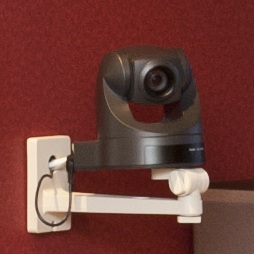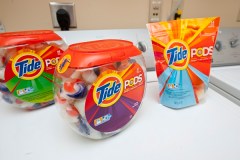Laundry detergent is not my regular beat. But when Procter & Gamble invited me to check out one of its secret lairs, with a PR rep touting “advanced modeling and virtual reality” within, I couldn’t resist.
Yes, the maker of Tide, Bounty, Duracell, Head & Shoulders and countless other household brands has a secret lair near its Cincinnati, Ohio headquarters. It’s one of 52 P&G “Innovation Centers” around the world, and until this week, the press has never been allowed inside any of them. My request to bring a camera was denied.
(MORE: Making P&G New and Improved)
The occasion for lifting the veil of secrecy was a new line of detergent, called Tide Pods. These little packets of polyvinyl, roughly the circumference of your thumb and forefinger together, are stuffed with highly concentrated detergent, along with isolated swirls of stain remover and brightener. Instead of measuring a cup of liquid, you drop the whole Pod into the wash, and it dissolves at any temperature. P&G regards this as a revolution–the iPad of detergents, if you will. Apparently for every year you use Tide Pods, you’ll save an hour.
The Beckett Ridge Innovation Center, a 137,000 square-foot building in the middle of a West Chester, Ohio office park, had little to do with the science behind Tide Pods. The actual experiments go down at other centers. The BRIC, as it’s called, is all about figuring out how people go about their lives so P&G can learn how to make its products better. That’s where the technology comes in.
Just beyond the BRIC’s reception area is a model supermarket, which would be frighteningly accurate if it wasn’t so immaculate. Bounty, Tide, Tampax and Pringles are arranged in rows along pristine aisles. Fluorescent lights hum. The place even smells like supermarket.
 But what I didn’t immediately notice is that the room is rigged with cameras. Focus groups come here, and P&G records the shoppers’ every move, analyzing where they look, and how they interact with their groceries. The footage collects on an internal server so P&G employees at other Innovation Centers can watch.
But what I didn’t immediately notice is that the room is rigged with cameras. Focus groups come here, and P&G records the shoppers’ every move, analyzing where they look, and how they interact with their groceries. The footage collects on an internal server so P&G employees at other Innovation Centers can watch.
In another wing of the center, a model home serves the same purpose. And like the supermarket, it’s just a little too perfect to be real. The leather couches smell new. The kitchen’s breakfast bar alone is bigger than my dining room table. In a home office room in the distance, I spied what looked like the most beautiful thin-and-light laptop I’ve ever seen (and didn’t get to play with it). Again, people come here to pretend to live, interacting with P&G products so the company can gather data. In total, the BRIC has more than 50 cameras. The only room without one is the toilet, which is closed off from the rest of a massive bathroom. (Participants wear bathing suits in the shower, we were assured.)
From all this research, P&G surmised that laundry was too complicated. Different load sizes. Different stain types. Different water hardness. Different water temperatures. The company says there are 900 possible conditions when doing a load of laundry, and 20 percent of the time, people re-wash their clothes because they aren’t satisfied. Tide Pods are supposed to be the equalizer, able to produce consistent results in most conditions. (I haven’t tried my free sample yet; I’m saving it for a really complicated load.)
 Even with the product complete, there’s work to be done at the BRIC. One of the final stops on our tour was a dark room, surrounded by curtains, with three square displays lined up against a wall. Each one seemed well over six feet tall and wide, and with the press of a button, the two outer screens folded inward, so the floor and three screens formed part of a cube.
Even with the product complete, there’s work to be done at the BRIC. One of the final stops on our tour was a dark room, surrounded by curtains, with three square displays lined up against a wall. Each one seemed well over six feet tall and wide, and with the press of a button, the two outer screens folded inward, so the floor and three screens formed part of a cube.
My fellow reporters and I donned 3D glasses and stepped inside the cube, and the displays turned into a model of the fake supermarket we’d walked through earlier. Someone–I couldn’t see who–was controlling the action, walking us through the aisles, and then floating us off the ground for a birds-eye view of the store. One reporter got queasy and took her glasses off. That’s when I realized the floor was a display, too.
Occasionally, P&G will invite retail partners to partake in this gimmick. The company takes pictures of the retailer’s store, then weaves those photos into a 3D model. Retailers can get a feel for how a new product looks on store shelves, and can play around with different arrangements. Sadly, we didn’t get to see any of that; I got the sense that I was the only reporter more interested in the virtual reality than the detergent.
Aside from the technology and the detergent, one other thing struck me during my tour of the BRIC: During a presentation, Alex Keith, P&G’s general manager of fabric care in North America, said the company wanted to “surprise and delight” people. It’s a popular phrase, but I knew I’d heard it somewhere specific. At home, Google helped me remember: It was Steve Jobs, during Apple’s Antennagate press conference in 2010:
“We love our users. We try very hard to surprise and delight them, and work our asses off doing it,” he said.
Maybe technology and laundry detergent aren’t all that different.
(MORE: Why Technology and Innovation Are Critical to America’s Future)

